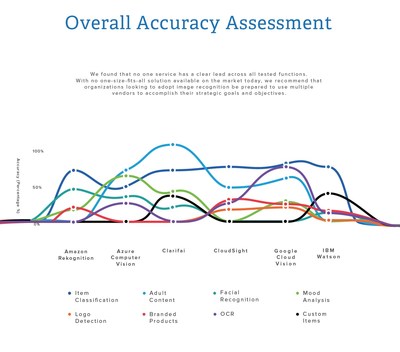TMCnet News
Accuracy of Six Leading Image Recognition Technologies Assessed by New CapTech StudyRICHMOND, Va., June 22, 2017 /PRNewswire-USNewswire/ -- Businesses and government agencies are increasingly eager to adopt Artificial Intelligence (AI) solutions, including image recognition technology, to incorporate a variety of game-changing opportunities into their ways of operating. Spurred by growing client needs, CapTech, a national IT management consulting firm, recently conducted an independent study to assess the accuracy of six leading image recognition services and today released the full study and infographic detailing their strengths and shortcomings.
A recent Forrester Research report, "Artificial Intelligence: A CIO's Guide to AI's Promises and Perils," discussed the transformative nature of AI and how its deployment will help companies create significant value. The Forrester research shows that more than 55% of enterprises are investing in AI and image recognition in combination with machine learning as a leading area of focus. According to CapTech, image recognition services promise to drive new capabilities and efficiencies while transforming customer service across diverse industries. The marketers of these services pitch them for a wide range of imaginative uses, such as e-commerce, security screenings, visual search, identity logins, and preventing adult or violent content from making it onto social media. "Providers of image recognition software services are offering rising sophistication of functionality. However, current services have limitations that users in business and government should be aware of," said Jack Cox, a software engineer, systems architect, and Fellow at CapTech. "Our study evolved from the need to help our clients develop strategies to leverage image recognition services and integrate the technology with new or existing systems to get the greatest value from these services and achieve a competitive advantage. "We found that no one service has a clear lead across all tested functions. With no one-size-fits-all solution available on the market today, we recommend that organizations looking to adopt image recognition be prepared to use multiple vendors in order to accomplish their strategic goals and objectives. In addition, because of the rapid pace of change in this industry, we recommend that integraton of existing systems with image recognition services be architected to provide maximum flexibility so that organizations can switch vendors as needed and adapt to the rapidly changing image recognition landscape," said Mr. Cox. CapTech presented each service with the same set of approximately 4,800 images, distorting many to recreate real-world conditions such as blurring, overexposing or underexposing, positioning the images at odd angles, and otherwise recreating real-world conditions. CapTech evaluated the services in nine distinct areas of function including facial detection, facial recognition, mood analysis, text recognition, logo recognition, branded product identification, adult content detection, item classification, and item recognition. Based on the results of the accuracy tests, CapTech concluded that it is unlikely that any one service by itself will meet all the image recognition needs of a business or government agency. Each service excelled in some functions but came up short in others. Based on the study results, CapTech recommends that organizations planning to use image recognition services consider the following tips:
The full study, Image Recognition Services: Searching for Value Amid Hype, is available on CapTech's website. The study's findings are also available in an infographic Help or Hype? An Unbiased Image Recognition Services Vendor Assessment. About CapTech: CapTech (www.captechconsulting.com) is a U.S.-based technology and management consulting firm that partners with some of the world's most successful companies to achieve their strategic and business objectives. We bridge the gap between business and technology through a collaborative approach that helps organizations grow their business, engage with customers, and turn data into powerful insights. We are headquartered in Richmond, Virginia, with locations in Atlanta, Baltimore, Charlotte, Chicago, Columbus (Ohio), Denver, Orlando, Philadelphia, San Francisco, and Washington D.C. Contacts Leslie Strickler Lou Anne J. Nabhan Links:
Contributing Researchers: Jack Cox, Fellow Chris Heinz, Senior Consultant Kevin Vaughan, Manager
To view the original version on PR Newswire, visit:http://www.prnewswire.com/news-releases/accuracy-of-six-leading-image-recognition-technologies-assessed-by-new-captech-study-300477009.html SOURCE CapTech 
|


